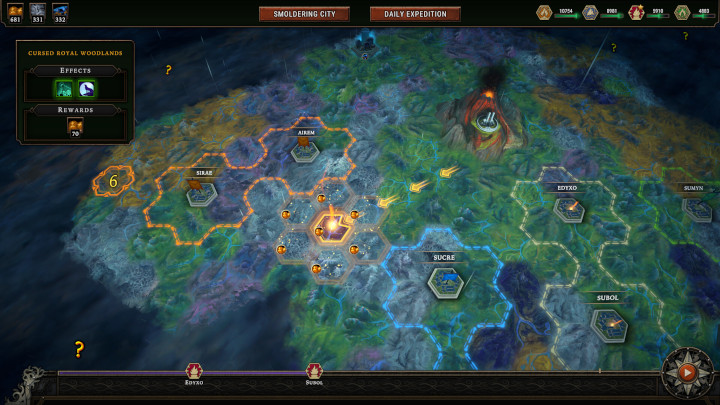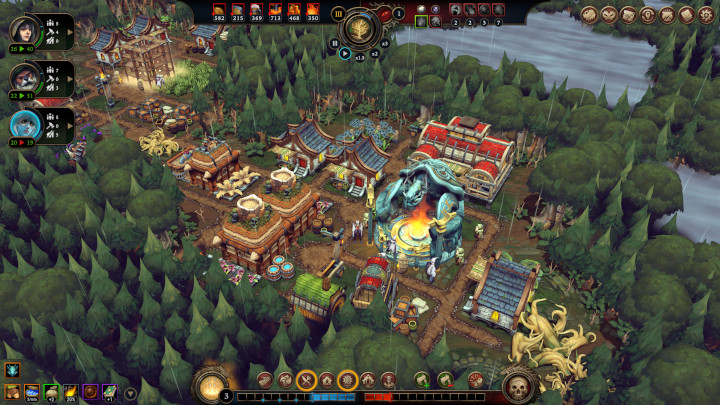
If you’re a fan of real-time strategy games, or city builders, or colony management games, then you really, really need to check out Against the Storm. This game enters Early Access on Steam today (November 1, 2022), and publisher Hooded Horse was kind enough to give me an early copy of the game ahead of its Early Access launch.
So I’ve been dabbling with this one for a few days now. I haven’t had the time to dig in super deeply at this point, but what I’ve played so far has absolutely blown me away. Against the Storm is a serious contender in the colony-management video-game genre.
A huge part of this is just how charming it all is. You control a small village of anthropomorphic animals, each who has their own racial strengths and weaknesses. For example, you’ll typically want to make sure your Woodcutters’ Camps are staffed with beavers, while lizards tend to be better at hunting food.
But what really makes this work so well is the implementation of roguelite elements. Now, the terms roguelike and roguelite are becoming industry buzzwords at this point, which often leads developers to incorporate elements from these genres without really understanding what makes them click with their audience. But Against the Storm developer Eremite Games (hailing from Poland) has really done their homework.

The way this all works is that there’s an overworld map, which is chopped up into hexagon-shaped tiles (think Civilization). When you select a tile, you zoom in to reveal a randomly generated landscape, which is yours to explore, tame, and develop.
You’re given a series of tasks to complete, and doing so fills a blue meter at the bottom of the screen. This blue meter, however, is in direct competition with a red meter, which signals the Queen’s level of impatience with your colony-building efforts. If you dawdle too long, or if your colonists are too unhappy with how you’re running things, the red meter fills. If the blue meter fills before the red one, you win. But if the red meter fills, you lose.
Whether you win or lose, you’re zoomed back out to the hexagon grid, where you can choose a new tile and start the process all over again. You do get XP for playing, and this gives you access to an upgrade tree that can give you a better start the next time you zoom back into the colony-management part of the game.
While you’re zoomed into the colony-management sections, hitting certain milestones will grant you bonuses, which allow you to choose between various building blueprints that help you grow out your settlement. You’re also given specific Orders from the Queen, and completing these is the fastest way to fill that blue meter. The trick, then, is to match your blueprints with your Orders. If you have an Order to deliver a set amount of vegetables, you’ll want to pick the small farm if you’re given the option.

Orders seem to be randomized, and your selection of blueprints also seems randomized, so the expansion of your settlement is somewhat dependent on luck. Plus, as you expand your village outward, you’ll break into clearings that are covered in fog. When you chop your way into one, the fog dissipates to reveal what’s usually a bonus, like a dilapidated building you can repair, or crates of supplies, or a camp of poor lost souls who will join your village. These bonus also seem randomized, and there are even “Dangerous Glades” marked with an evil-looking animal skull, and clearing these will give you better rewards but will also present some dangerous obstacle to overcome.
However, there are a couple brilliant features that empower you to persist even after getting dealt a bum hand.
The first is that your manufacturing buildings typically have alternate recipes for goods. For example, Fabric, by default, is made from Plant Fiber, but you can also manually adjust the recipe to instead make it from Reeds or Leather. So if your world is just depressingly sparse in one resource type, it won’t roadblock you from progressing, so long as you can find alternate resources to fill in the gaps.
The second feature that puts power into your hands is the simple fact that you can pick up any building and move it at any time without penalty. Yeah, so when you’ve chopped down all the trees around a Woodcutters’ Camp, simply pick it up and move it deeper into the forest. You don’t have to go through the tedium of destroying the building, rebuilding it, then manually reassigning workers to it — you just pick it up and plop it down wherever you want it to go. I can’t even begin to express how much of a game-changer this is.

And did I mention that this game is gorgeous? The fantasy-style architecture is lovely, and there’s this neat blur effect that impacts the edges of the screen to give it a tilt-shifted look. I don’t know why, but I’m kind of a sucker for this type of visual magic.
As I mentioned at the beginning of this article, Against the Storm deserves a much deeper look than I’ve been able to give it over the past few days. But even at a glance, it’s shaping up to be an incredibly addictive colony-management game that I can see myself sinking dozens of hours into once my schedule clears up a little bit. Perhaps I’ll spend the holidays micromanaging anthropomorphic beavers and lizards as we conquer this hexagon-filled world. That sounds lovely, actually.
Disclaimer: I was given a review code for Against the Storm on Steam, but the opinions expressed in this article are my own.